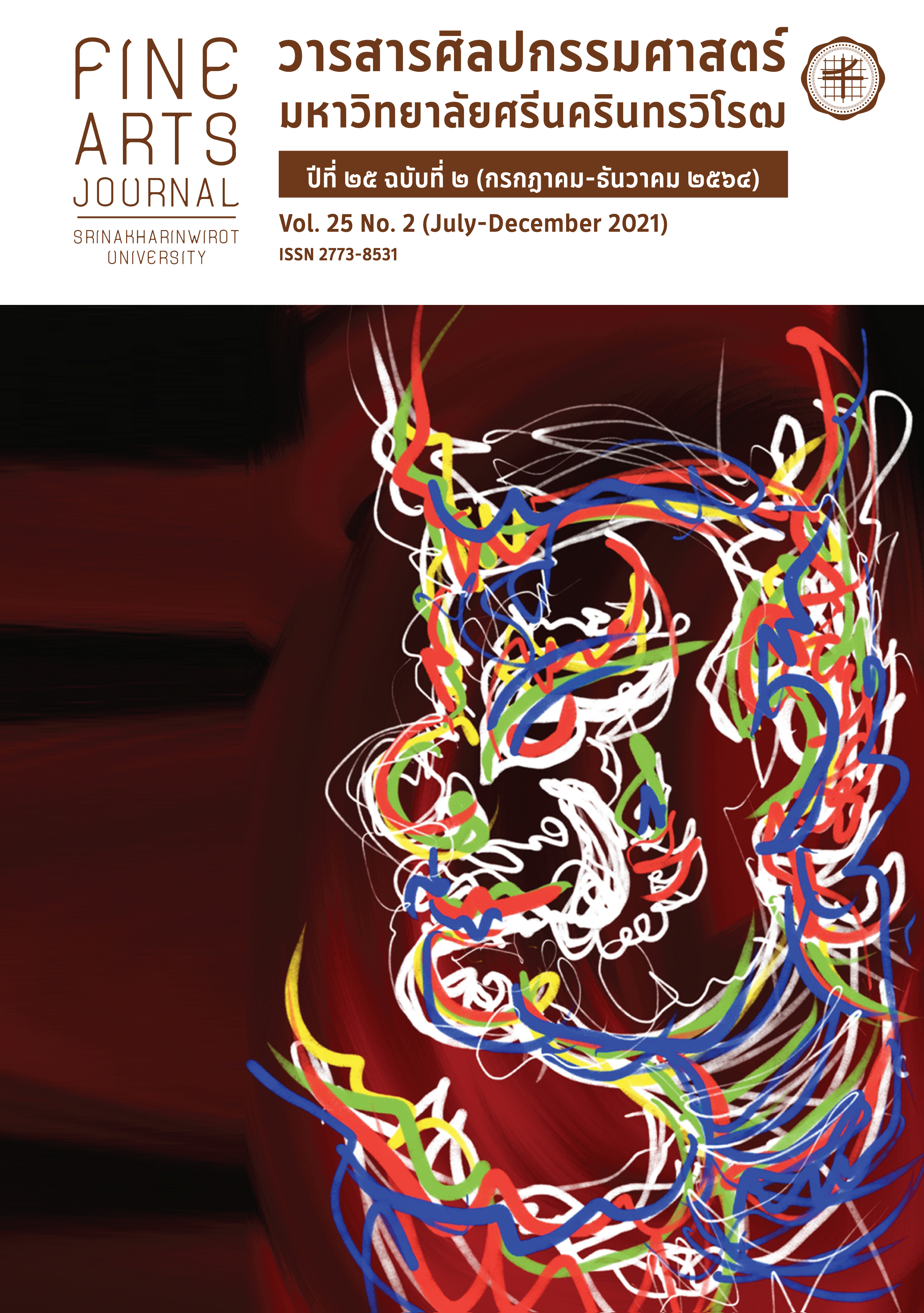THE PERFORMANCE ELEMENTS OF LAM HAB TAENG TUA DANCE
Keywords:
The performance elements, Solo dance, Lam Hab Taeng Tua danceAbstract
The purpose of this article is to study the performance elements of Lam Hab Taeng Tua dance (Thai Traditional Dance about Lam Hab’s Costume) which is a solo performance by Nang Lam Hab, the dancer. The story of the dance is a chapter of a dance drama, Chapter: Wedding of Ngo Pa, written by Phra Chula Chom Klao Chao Yu Hua (King Rama 5). The chapter is about the roles of Nang Lam Hab, who shows the processes of taking a shower, getting dressed, and wearing makeup before her wedding with Ha Nao. This reflects the beautiful female costumes and dressing styles of the Ngo Za Kai people. The dance moves were created by Lady Paew Sanitwongsanee, a national artist.
According to the author’s direct experiences in learning Lam Hab Taeng Tua dance from Ajarn Walaibhorn Krathumket, a senior Thai dance artist of the Thai Dance Group of the Office of the Music and Drama of the Fine Arts Department, the performance elements of Lam Hab Taeng Tua dance are also considered another important component to make the performance more realistic and perfect apart from the demonstration of dance moves and the practices that should support the dancer’s skills. The performance elements can be divided into eight sub-components: scripts, casting, soundtracks, dance styles, performance area, props, costumes and lights. The outstanding component of Lam Hab Taeng Tua dance is emphasized on the elegance of female Ngo Za Kai’s dressing styles which are extraordinary and different from female protagonists of other plays. Thai dance masters created this knowledge that has been inherited until now. This reflects the wisdoms of the Thai dance traditions that are valuable and should be inherited properly. Moreover, Lam Hab Taeng Tua dance is considerably valuable for those who would like to learn about anthropology, sociology and ethnology which can well reflect Ngo Za Kai people’s way of life in the South of Thailand.
Downloads
References
จุลจอมเกล้าเจ้าอยู่หัว. พระบาทสมเด็จพระ. (2553). บทละคร เรื่อง เงาะป่า. กรุงเทพมหานคร: แสงดาว.
ณรงค์ชัย ปิฎกรัชต์. (2535). สารานุกรมเพลงไทย. กรุงเทพมหานคร: เรือนแก้วการพิมพ์.
ธรากร จันทนะสาโร. (2557). นาฏยศิลป์จากแนวคิดไตรลักษณ์ในพระพุทธศาสนา (วิทยานิพนธ์ปริญญา
ดุษฎีบัณฑิต). จุฬาลงกรณ์มหาวิทยาลัย, กรุงเทพมหานคร.
ผุสดี หลิมสกุล. (2549). รำเดี่ยวมาตรฐานตัวนาง. กรุงเทพมหานคร สำนักพิมพ์แห่งจุฬาลงกรณ์มหาวิทยาลัย.
พัชรินทร์ สันติอัชวรรณ. (2562). หลักการบรรจุเพลงประกอบการแสดงรำเดี่ยวมาตรฐานตัวนาง. วารสาร
ดนตรีรังสิต มหาวิทยาลัยรังสิต, 14(1), 12-25.
พัชรินทร์ สันติอัชวรรณ. (2561). หลักนาฏยประดิษฐ์ไทยจากศิลปินต้นแบบตัวนาง สู่นวัตกรรมการสร้างสรรค์
รำเดี่ยวมาตรฐาน. วารสารศิลปกรรมศาสตร์ จุฬาลงกรณ์มหาวิทยาลัย, 5(2), 83-94.
มัทนี รัตนิน. (2559). ศิลปะการแสดงละคร หลักเบื้องต้นและการฝึกซ้อม. กรุงเทพมหานคร: โรงพิมพ์
มหาวิทยาลัยธรรมศาสตร์.
ยุพร แสงทักษิณ. (2557). เงาะป่า วรรณคดีสัญลักษณ์แห่งรัชสมัย. กรุงเทพมหานคร: สกสค. ลาดพร้าว.
ฤดีชนก คชเสนี. (2544). นางจันทน์แต่งตัว ลำหับแต่งตัว (รายงานอาศรมศึกษาทางนาฏยศิลป์ไทย).
จุฬาลงกรณ์มหาวิทยาลัย, กรุงเทพมหานคร.
ศรัณย์ภัทร์ บุญฮก. (2562). บทละคร เรื่อง เงาะป่า: จากข้อมูลคติชนสู่การสร้างสรรค์วรรณคดี. วารสารไทย
ศึกษา, 15(1), 105-135.
ศิลปากร, กรม. (2559). ศิลปิน ศิลปะ ศิลปากร พ.ศ. 2559. นนทบุรี: ไทภูมิ.
สทาศัย พงศ์หิรัญ. (2557). ดรสา แบหลา: นาฏยศิลป์สร้างสรรค์จากวรรณคดีไทย เรื่อง อิเหนา (วิทยานิพนธ์ปริญญาดุษฎี
บัณฑิต). จุฬาลงกรณ์มหาวิทยาลัย, กรุงเทพมหานคร.
สุนันทา เกตุเหล็ก. (2556). แบบแผน ลีลา และกระบวนท่ารำลงสรงทรงเครื่องตัวนางละครใน
เรื่อง อิเหนา (วิทยานิพนธ์ปริญญามหาบัณฑิต). จุฬาลงกรณ์มหาวิทยาลัย, กรุงเทพมหานคร.
เสาวณิต วิงวอน. (2555). วรรณคดีการแสดง. กรุงเทพมหานคร: ศักดิโสภา.






